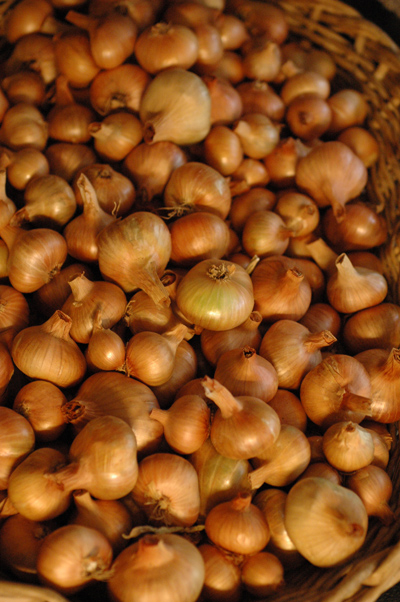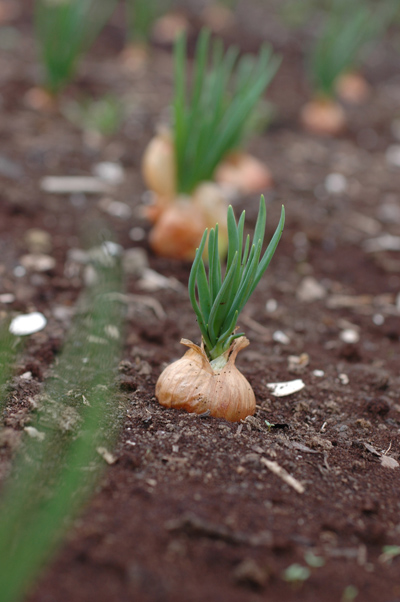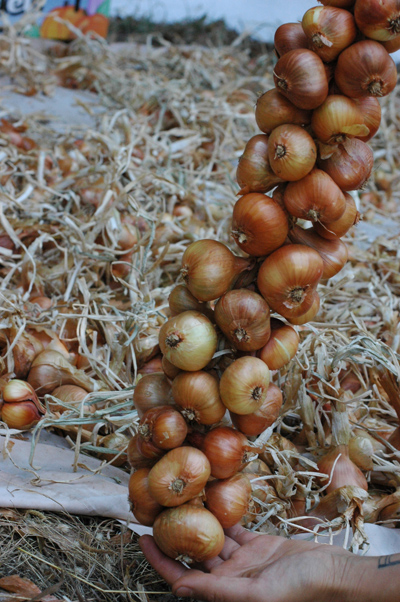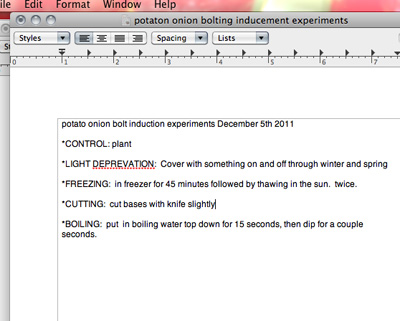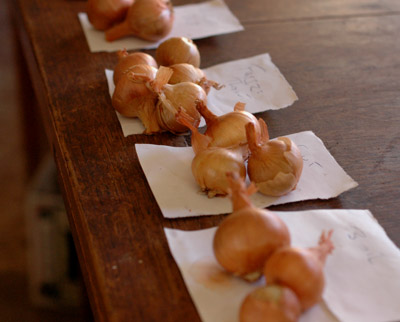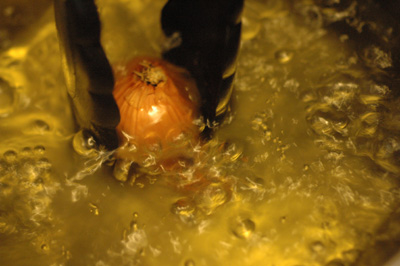I would like to introduce you to a swell onion that makes its own starts, stores like a rock and tastes great! (Related post: Potato onion research.)
Years ago when sharing a garden with my mother, she ordered some small onion sets called potato onions. From that small beginning we've been growing them ever since and have given away dozens of starter bulbs. The potato onion somewhat resembles a shallot in growth habit. They tend to be a little bit smaller than shallots and somewhat more rounded. The bulbs are delicious caramelized, cooked whole in stews and roasts, grilled in their skins on the barbecue and about anywhere you would use a regular storage type onion. I like potato onions.
I'm really into onions right now. I'm starting to dream about growing more different varieties and I'm even filling the spring gap between the last leeks and the first scallions with a few store bought onion bulbs. For many years though I pretty well subsisted on only three types of onions from the garden- the leek, scallions and potato onions. The leeks provide much of the winter fare in the onion department, the scallions are the first in the spring after the leeks have gone to seed and the potato onions keep through the winter and into the summer for use whenever a non-green onion is needed or when the leeks and scallions aren't available. Its been a pretty good system. Regardless of what other Onions I might try growing, I don't think that potato onions will ever be left out of my garden.
One of the great things about potato onions is that they are grown from bulbs so you never have to start them from seed. The bulbs keep remarkably well, so there are always starter bulbs to plant as late as mid summer. One bulb planted will produce usually 5 to 8 more bulbs, though sometimes more. I've tried to grow shallots from bulbs before with limited success. The shallots seem to bolt every time, but the potato onions rarely try to flower before they are ready to dry off and store away. I have seen them flower, but its a rare occurrence here.
I plant the bulbs shallowly by pushing them about one half to two thirds of the way into the ground. I don't bury them or push them all the way down. They like to grow mostly out of the ground. They will start rooting very soon if the soil is moist. I usually space them around 8 to 10 inches apart in every direction in a grid pattern. Onions tend to like to be well fed and especially seem to thrive on nitrogen. I give them a lot of nitrogen through the growing season in the form of diluted urine at about 1/3 urine to 2/3 water. Onions like that.
The plants get onion thrips like any other onion and occasionally have some rust, but neither of those problems has ever been so bad as to warrant any intervention on my part and they seem otherwise unaffected by pests and diseases and .
When do you harvest potato onions? At some point your plants will start to look rough and the tips of the leaves begin to die back. This occurs before they are actually sized up all the way. Once the plants seem to be really declining, lets say that half of the foliage is dead, stop watering the plants and let them harden off and finish on their own. In another few weeks, they wilt most of the way down and can be pulled up. I read somewhere or was told that one should allow onions to dry off most of the way on their own before pulling and though I've never tested or confirmed its validity, I've always used this approach with good results. Normally, the onions will have almost no live roots left when I pull them up. If I need the bed I'll pull them a little early, but I want the tops mostly dead at least.
I usually dry the onions under a tree in the shade with the greens still on. Spread out in a layer one onion thick. Once dry the remaining tops can be trimmed off to 3/4 of an inch or so, and the onions stored in a cool dry area through to the next summer. They keep extremely well, although there are always a small percentage that go bad.
The tops can also be braided together by drying the tops first and them dipping them briefly in water and waiting a few minutes until they become flexible enough to work with.
I guess the only real drawback to potato onions is that they are some work to peel. They are packed with flavor though and I find them easily worth the effort. I like to throw some sliced into a pan in which I've just cooked some meat and pour in a little white wine or cider to lift the glaze. Then cook them down repeatedly with a splash of cider each time they cook dry until they are good and caramelized. Another favorite around here is throwing them on a charcoal grill whole with the skins still on. When they're well done they can be squished out of the skins as they are eaten. Yum! For stews with large pieces of meat and vegetables, or for roasts, I peel them, but leave them whole.
This year I've planted more potato onions than ever and I'm really looking forward to eating them in a few months. Give potato onions a try and if you aren't an over privileged, entitled brat that can't stoop to taking an extra minute of inconvenience to peel a few small onions I think you'll be glad you did! Well, to be fair, I'm sure there have been many times when weary from the days activities I found peeling a pile of potato onions less than appealing, but like so many things once you reset your expectations and start to view your food in new lights, peeling a few small onions instead of one big one ain't so bad after all.
Where to go with potato onions from here: I've tried planting out the early planted crop again as soon as it is mature hoping for a second generation of onions in one growing season. While I think there is adequate time to make this approach work, the onions have refused to wake up and grow without being stored for an undetermined amount of time. Unless there is a way to quickly break their dormancy by chilling or other means, it looks like one generation a year will have to do.
One experiment I plan to carry out next year is to plant some very early, even in late winter maybe, and then plant successions. The bulbs can be eaten when still young and green, so they might make early greens with the bulk allowed to mature in early summer for a supply of summer grilling onions. The successions or late plantings can then supply the winter and spring storage onions. No use growing them out early just to store them through much of the summer.
I have occasionally seen potato onions flower. I think someone out there should start breeding these for more variety. We could end up with other colored, other flavored, bigger sized or otherwise different potato onions than we have now. From what I've been able to find, they seem to be the same species as regular bulbing onions and shallots so those varieties, of which there are so many, could be used as the other parents making for a multitude of possible outcomes. If mine flower again I'll be tempted and I may even try to trick them into flowering for that purpose. (Since writing this, I've found someone who is breeding new potato onions, though not using the self fertile potato onions rather than crossing them out with anything else. Kelly's site has information about his experiments and results, check it out!
This page at gardenorganic.org from the UK also has much information on potato onions. They recommend planting deeper than I do and planting in Autumn for larger yields. Also, they recommend digging carefully and storing without breaking the bulbs apart. I plan to try all of these suggestions this next year.
Potato onions are hardly grown anymore and most people have never heard of them although they used to be quite popular. By growing and giving away potato onions you can help save them from extinction. Forward this article to a gardener you know and help revive our potato onion heritage!
Fedco/moose tubers carries potato onions and they are hands down my favorite seed company anyway, so check out the seed section as well. http://www.fedcoseeds.com/moose.htm
Also check out:
http://www.southernexposure.com
https://www.mainepotatolady.com
--------------------------------------------------------------------------
UPDATE, 12/7/2011
POTATO ONION TORTURE
Plants tend to bolt under stress, so I racked my brain for ways to stress potato onion plants to induce flowering. I came up with the following list which was carried out on groups of 3 before planting yesterday including one control group. I know it looks pretty rough, but its for the good of the species. the potato onion race is run down and needs an infusion of new genes to regain its former glory!
I also planted some of the potato onions this past season too late... maybe sometime in July? Those onions didn't mature. They are still green and the bulbs are small. I'm leaving a few clumps of them in the ground in the hopes that they will bolt this spring. I hope to encourage a few of them using light deprivation and whatever else I can think up. I hope also to have a few other onions flowering at the same time so that I can make intentional crosses with varieties of single bulbing onions. Stay tuned for results...
--------------------------------------------------------------------------
UPDATE MARCH 14 th 2012:
I just finished compiling, cleaning up and publishing some research on Potato Onions gleaned from old books and journals. You can read it here----> O. Also, all but two of the tortured onions are growing now, but only one to three inches tall.
___________________________________________
UPDATE JUNE 4th 2012:
I was super stoked to see a flower emerge from one of my Potato Onion bolting induction experiments! It was from the bulbs that were cut at the base. Then another! Then some flower stalks from the onions I planted too late last season and left in the ground all winter. I think I was feeling a little smug in my success. Then I saw flowers coming out of this years normally planted regular Potato Onion crop, which is unpreferable really. No torture, no overwintering in the ground. Coincidence? I wonder. Someone once told me that one should always snap the heads off of flowering onions because if you let onions flower, they "tell" the other onions which can cause them all to flower. I have never confirmed that or heard it elsewhere, but it makes sense from an evolutionary standpoint. Maybe I did induce flowering and those onions did tell the other onions to flower. Then again, maybe it's just coincidence after all. Whatever the case, I now have A LOT of potato onions going to flower. I also have a couple other varieties of bulbing onions flowering for potential crossing. Hopefully that means I'll have a lot of seeds to grow out into new varieties of potato onions!
Just FFR the potato onions that bolted first were two of the ones which had cut bases. That is a I cut a cross pattern into the bottom plate of the onion bulb. The second to flower, shortly after were the overwintered bunches which are producing copious amounts of flowers.

